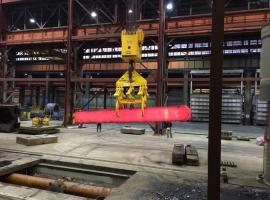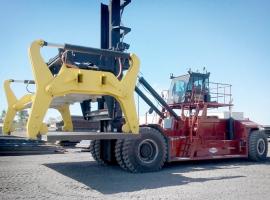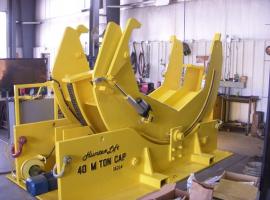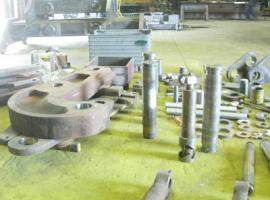In this blog post, we will explore some of the key reasons below the hook lifting devices are essential for lifting. We will also examine some of the different types of devices available and discuss how to use them to improve your lifting process. Read on to learn more!
Importance of Below-the-Hook Lifting Devices
There are many dangers associated with plant operations, and one of the most prevalent is lifting accidents. Every year, thousands of reported incidents of workers being seriously injured or killed while performing lifting tasks. To keep workers safe, it is essential to have effective lifting safety measures in place. Below the hook lifting devices are one of the most critical tools for preventing lifting accidents.
Below the hook lifting devices are designed to be used with specific materials and loads. They attach directly to the load and provide a secure connection that can support the weight of the load. This device is much safer than rigging because it eliminates the risk of the load becoming detached and falling.
There are many different types of rigging available, and each one is designed for a specific type of load. The most common type of rigging is the sling, which is used to lift heavy loads such as pipes or machinery. Slings are available in various materials, including nylon, polyester, and chain. Another type below the hook lifting device is the spreader bar, which is used to lift loads too wide to be lifted with a sling. Spreader bars are often used to lift heavy machinery or large containers.
Below the hook lifting devices are an essential part of any lifting operation. They provide a secure connection between the load and the lifting device and help to prevent accidents. When selecting this device, choosing one appropriate for the load lifted is essential. Using the proper device, workers can stay safe while performing lifting tasks.
Reasons Why These Lifting Devices Are Essential
There are many reasons that below the hook lifting devices are essential to lifting safety in plant operations.
Stable Base
One reason is that they provide a stable base for the lifted load. This is important because it prevents the load from shifting during the lift, which could lead to an accident.
Distribute the Load Evenly
Another reason below the hook lifting devices are essential is that they help distribute the load's weight evenly. This is important because it helps prevent undue stress on any part of the lifting apparatus, which could lead to failure.
Protect Workers
Finally, below the hook lifting devices can help protect workers from being injured by the load being lifted.
Bottom Line
So, as you can see, there are many reasons below the hook lifting devices are essential to lifting safety in plant operations. If you are responsible for lifting operations in your facility, be sure to use these devices to help ensure the security of your workers and equipment.
In this blog post, we will explore some of the key reasons below the hook lifting devices are essential for lifting. We will also examine some of the different types of devices available and discuss how to use them to improve your lifting process. Read on to learn more!
Importance of Below-the-Hook Lifting Devices
There are many dangers associated with plant operations, and one of the most prevalent is lifting accidents. Every year, thousands of reported incidents of workers being seriously injured or killed while performing lifting tasks. To keep workers safe, it is essential to have effective lifting safety measures in place. Below the hook lifting devices are one of the most critical tools for preventing lifting accidents.
Below the hook lifting devices are designed to be used with specific materials and loads. They attach directly to the load and provide a secure connection that can support the weight of the load. This device is much safer than rigging because it eliminates the risk of the load becoming detached and falling.
There are many different types of rigging available, and each one is designed for a specific type of load. The most common type of rigging is the sling, which is used to lift heavy loads such as pipes or machinery. Slings are available in various materials, including nylon, polyester, and chain. Another type below the hook lifting device is the spreader bar, which is used to lift loads too wide to be lifted with a sling. Spreader bars are often used to lift heavy machinery or large containers.
Below the hook lifting devices are an essential part of any lifting operation. They provide a secure connection between the load and the lifting device and help to prevent accidents. When selecting this device, choosing one appropriate for the load lifted is essential. Using the proper device, workers can stay safe while performing lifting tasks.
Reasons Why These Lifting Devices Are Essential
There are many reasons that below the hook lifting devices are essential to lifting safety in plant operations.
Stable Base
One reason is that they provide a stable base for the lifted load. This is important because it prevents the load from shifting during the lift, which could lead to an accident.
Distribute the Load Evenly
Another reason below the hook lifting devices are essential is that they help distribute the load's weight evenly. This is important because it helps prevent undue stress on any part of the lifting apparatus, which could lead to failure.
Protect Workers
Finally, below the hook lifting devices can help protect workers from being injured by the load being lifted.
Bottom Line
So, as you can see, there are many reasons below the hook lifting devices are essential to lifting safety in plant operations. If you are responsible for lifting operations in your facility, be sure to use these devices to help ensure the security of your workers and equipment.
Search
categories
- Select...
- Safety (13)
- Lifting Equipment (12)
- Company (6)
- Materials (5)
- Education (4)
- Services (3)
- Industries (3)
- News (3)
- Cranes (2)
- History (1)
Recent Posts
Comprehensive Guide to Below the Hook Lifting Devices The 6 Advantages of Below The Hook Lifting Devices The Keys to Safety and Design Requirements of Below-the-Hook Lifting Devices Why Below the Hook Lifting Devices Are Essential to Lifting? Requirements for Below the Hook Lifting Devicesarchives
- April 2023 (1)
- January 2023 (1)
- October 2022 (1)
- September 2022 (1)
- August 2022 (3)
- July 2022 (3)
- July 2017 (1)
- June 2017 (1)
- May 2017 (1)
- April 2017 (1)
- January 2017 (1)
- December 2016 (1)





